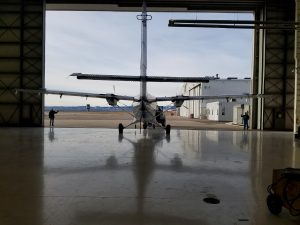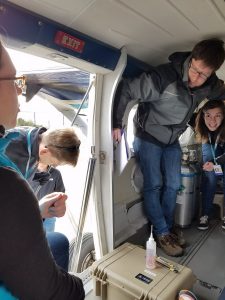
The Twin Otter leaving the hangar for its first test flight
After a week and a half of integration, we did our first test flights on January 12th and 13th. Sometimes called “shakedown flights”, they help us identify any issues with the instruments in the air that aren’t apparent on the ground. Test flights also let the ground crew and scientists practice the preflight maneuvers (such as refueling, turning on instruments in an order that won’t trip the breakers, etc.), plus the pilots can test out flying the Twin Otter with a full scientific payload at a time when we aren’t too concerned about the scientific results.
Unlike a lot of delicate scientific equipment, these instruments are specifically designed to fly, so they are relatively insensitive to vibrations and rapid changes in pressure that one would expect on a plane, but of course, there are always a few glitches. Even instruments that have flown on previous campaigns will run into a few problems here and there, and this time was no different.

CU Boulder during the second test flight
We had originally planned to do two test flights on the first day, one at 11 AM and another at 3 PM. However, the forecast was predicting snowy weather approaching that afternoon, so we decided at the last minute to push the second flight to the next day. The second hiccup occurred during the power transition. For the 3 hours before each takeoff, the plane is wheeled out onto the tarmac and the instruments are turned on and run off of ground power (basically a long extension cord from the hangar). Just before takeoff, the pilots switch over to aircraft power and the extension cord is disconnected. During our first attempt to switch power, a mixup occurred and we lost power for 2 seconds… and the NOxCaRD instrument wouldn’t turn back on. Because we were trying to beat the storm (and we were burning fuel on the ground), we ended doing the test flight with NOxCaRD powered off. But we made some speedy repairs late that afternoon, and by the second flight, it was ready to fly, and we were eventually able to test all instruments successfully.

Three simultaneous conversations occurring inside the cramped Otter
This experience was a good example of what is so tricky about aircraft campaigns. Problems spring up, but there isn’t a lot of time or space to fix them (see picture for an example of typical working conditions). So we try to prepare by packing a lot of spare parts and communicating with the other scientists and engineers to come up with creative workarounds. But the scientific results we get from aircraft campaigns make it worth it!
As soon as the test flights in Colorado were complete, we spent a day packing up a rental truck full of extra equipment and then several of us drove the truck while the others flew to Salt Lake City. It’s time to get otter here and head to Utah!
